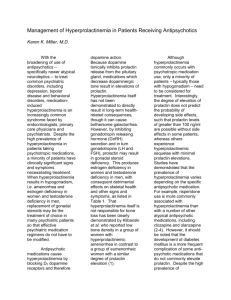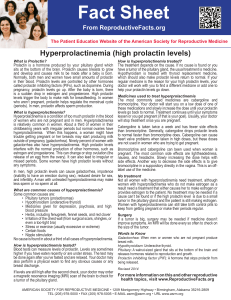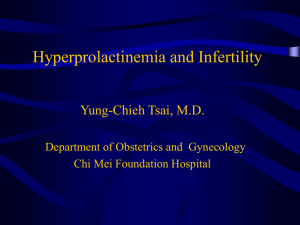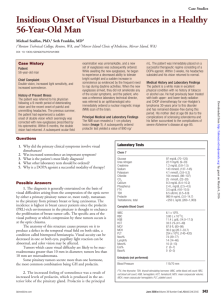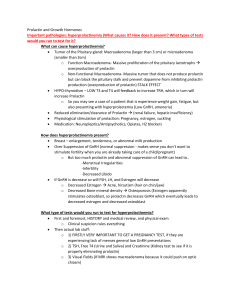Hyperprolactinemia: Causes, Symptoms, and Management
advertisement
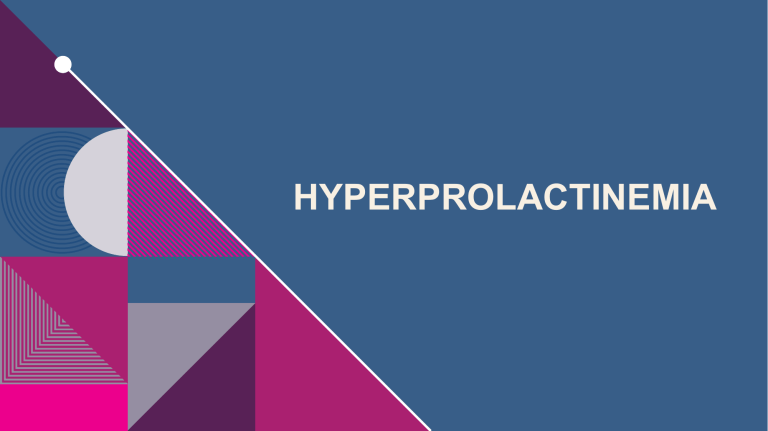
HYPERPROLACTINEMIA INTRODUCTION - REGULATION Normal levels : • Women - 5 to 25 ng/mL • Men - 5 to 15 ng/mL Levels fluctuate during the day and peak during sleep. • Prolactin stimulates milk production from the breast and modulates maternal behavior • Hyperprolactinemia occurs most frequently due to PRL-secreting pituitary adenomas (prolactinomas) & idiopathic hyperprolactinemia. • Occurs more commonly in Women 2 ENDOCRINE CAUSES OF HYPERPROLACTINEMIA Hypothyroidism Elevated TRH Stimulates PRL • Acromegaly is also associated with hyperprolactinemia as a result of the lactogenic properties of GH • Physiological hyperprolactinemia occurs in pregnant and breast-feeding women • Traumatic childhood experiences, such a separation from parents or living with an alcoholic father, have been reported to produce a greater predisposition to hyperprolactinemia. 4 CLINICAL PRESENTATION OF HYPERPROLACTINAEMIA IN WOMEN IN MEN frequently present with amenorrhoea & more rarely galactorrhoea in women Frequently present with impotence & infertility MACROADENOMAS ADENOMAS Headache & visual field disturbance due to focal erosion of the floor of the sella turcica or displacement of the infundibulum and pressure on the optic chiasm Prolactin-secreting adenomas are the most common type of pituitary tumor that causes hyperprolactinemia 6 HYPERPROLACTINEMIA SIGNS AND SYMPTOMS Sexual function • ovarian dysfunction • Infertility • reduced libido • atrophic changes in the urethra and vaginal mucosa • dyspareunia Breasts • Breast enlargement • Galactorrhea Reduced Bone mineral density - loss of the protective effect of estrogens on bone resorption Acne and mild hirsutism may also develop 7 8 RELEVANCE OF PSYCHIATRY IN HYPERPROLACTINAEMIA Increased rates of depression, anxiety and hostility ADR of the antipsychotic drugs • Women tend be more prone to the behavioral effects of prolactin than men • ‘Functional’ hyperprolactinaemia - raised prolactin in the absence of a pituitary adenoma. Endocrine marker of primarily psychological disturbance 9 MEDICATIONS AND HYPERPROLACTINEMIA • Typical neuroleptic medications can raise PRL level as much as 20-fold • Haloperidol is especially associated. (strong D2 blockade) • Atypical antipsychotics are less associated. Except in case of Risperidone (70 to 100%) • All SSRIs have been associated • Occurs in a dose dependent fashion & PRL level reaching plateau. Other medications include1. Oral contraceptives 2. Estrogens 3. TCAs 4. Metoclopramide 5. Verapamil 6. Propranolol 10 MANAGEMENT Investigations Thyroid function test Pregnancy test Chemistry panel Brain imaging study MRI with gadolinium CT with contrast Drug of Choice Alternative medications Bromocriptine Dopamine agonist reduces the synthesis and secretion of PRL ADR Severe nausea Dizziness Many patients cannot tolerate the side effects of bromocriptine Quinagolide Pergolide Cabergoline How Long? Medication discontinuation usually leads to a relapse of hyperprolactine mia Must continue indefinitely Refractory to medication? Radiotherapy Surgical removal through transsphenoidal surgery (not performed now) 12 THANK YOU REFERENCES Kaplan and Sadock’s Comprehensive Textbook of Psychiatry LISHMAN’S - Organic Psychiatry The American Journal of Psychiatry - 16 Dec 2019 15
